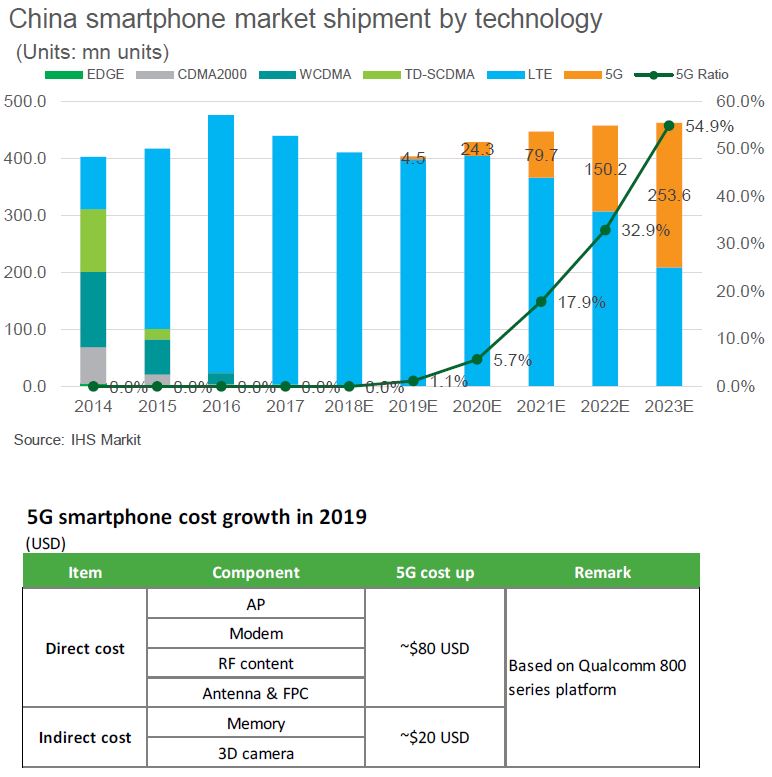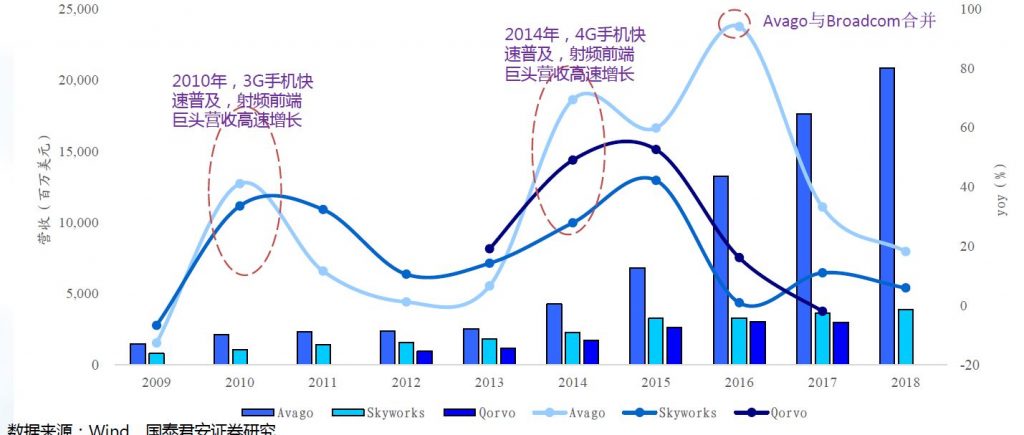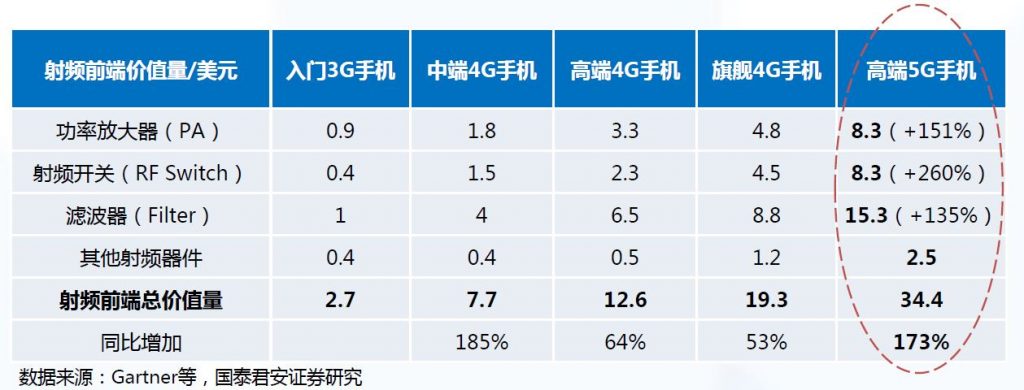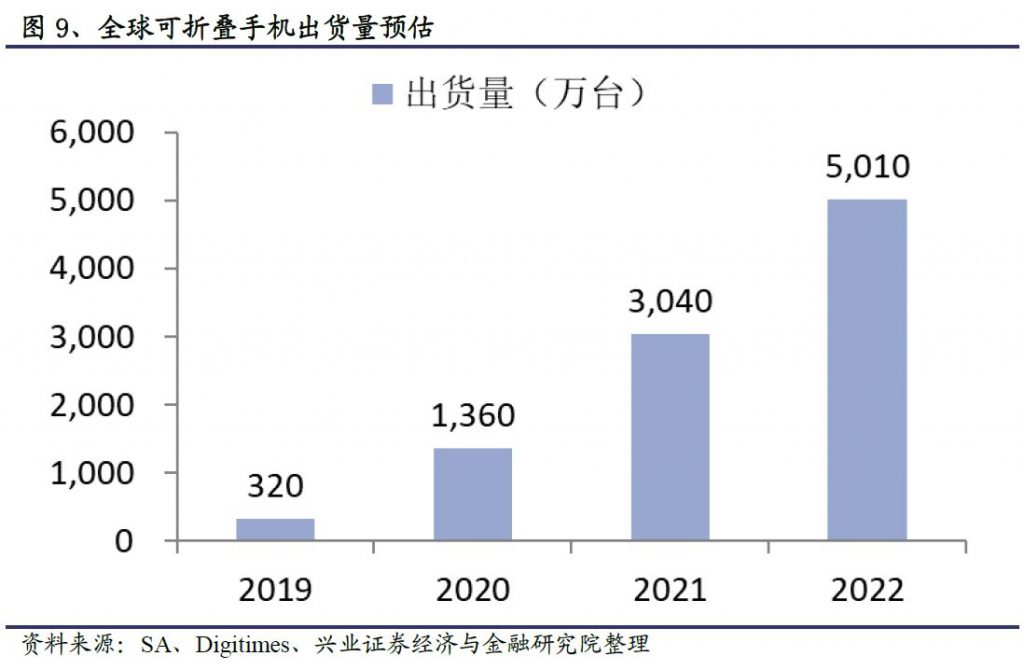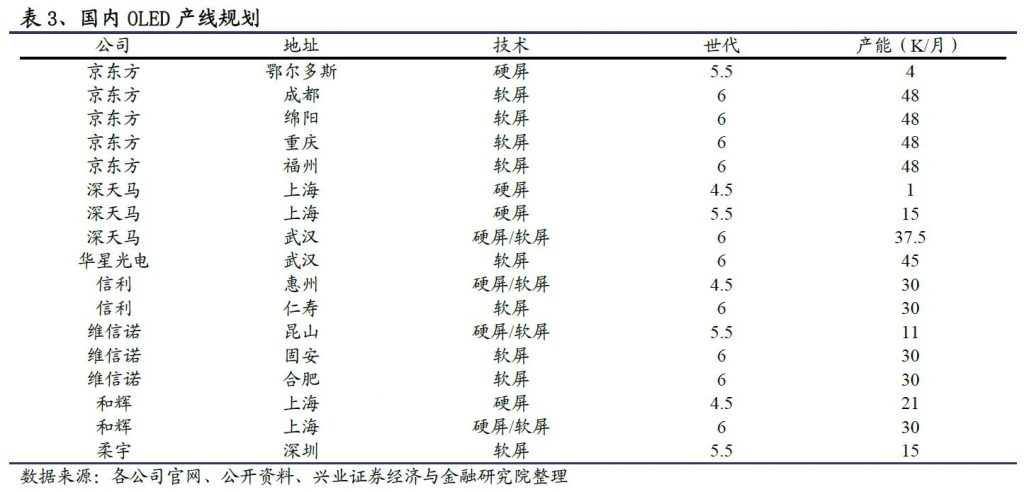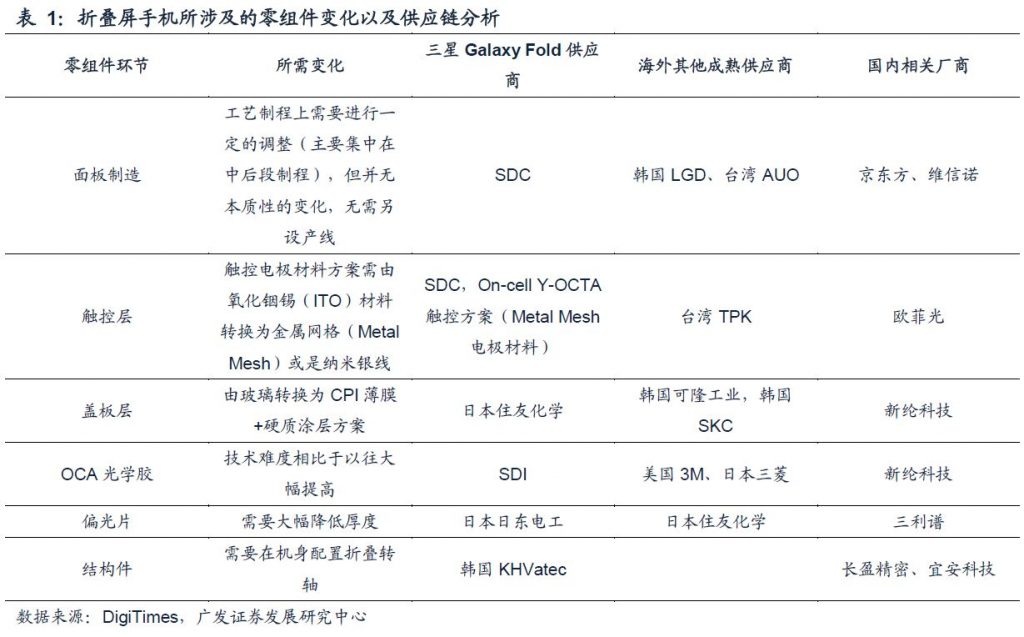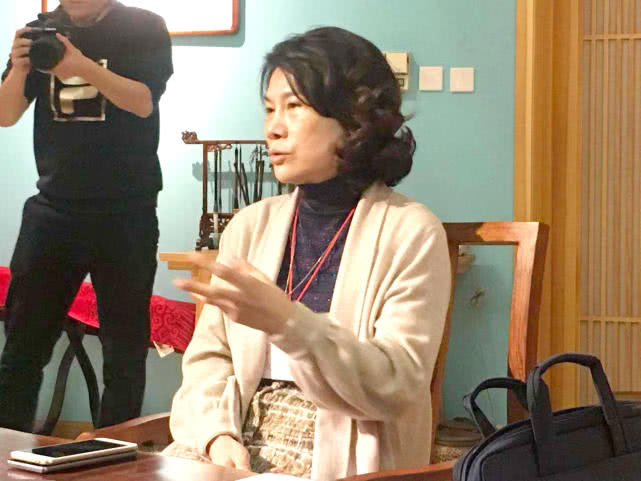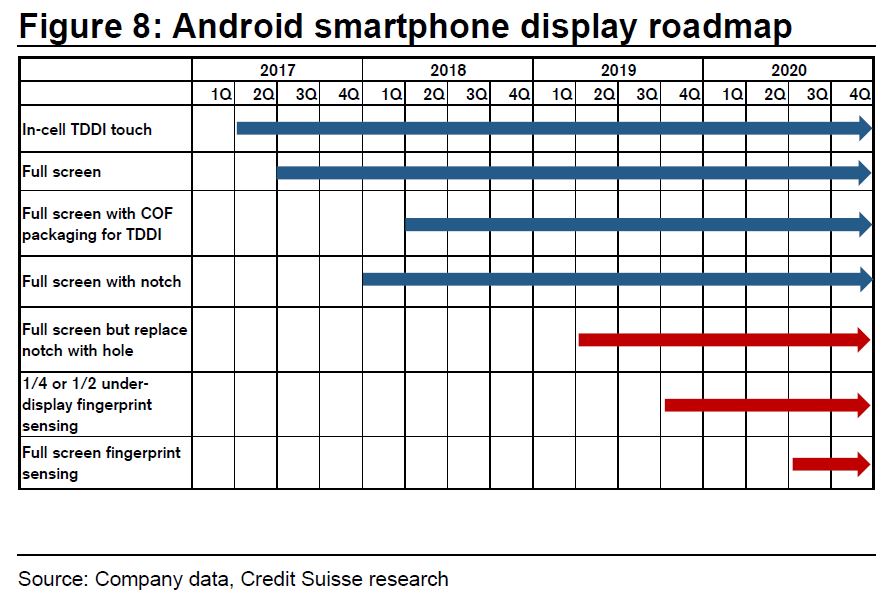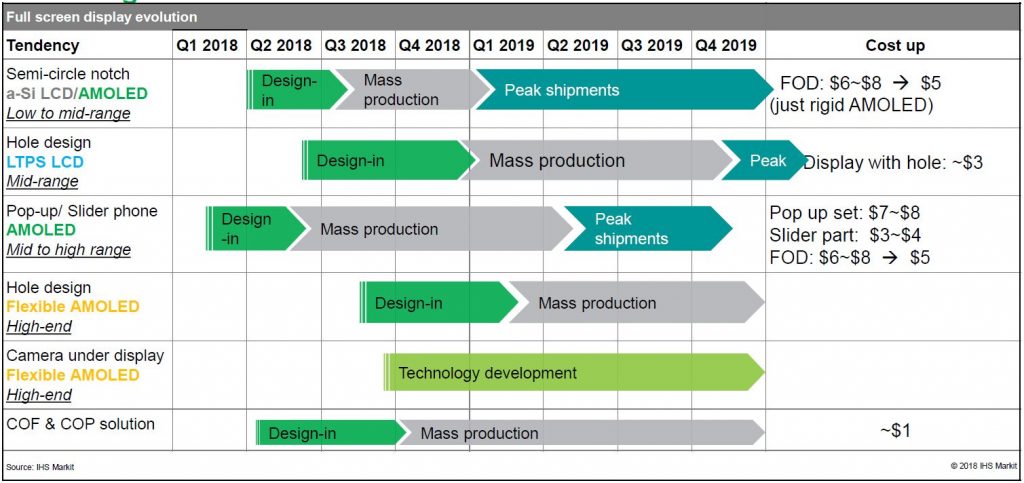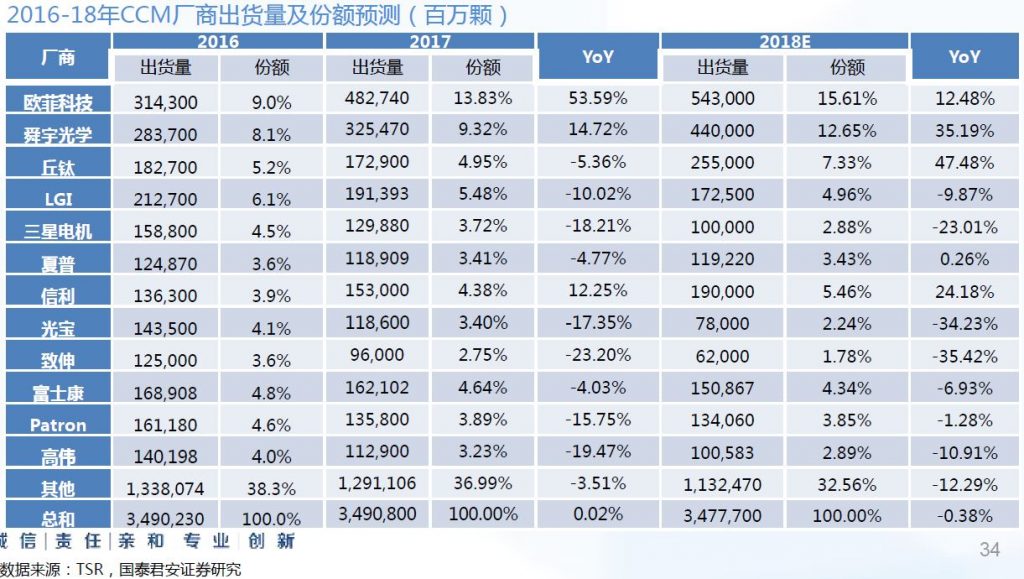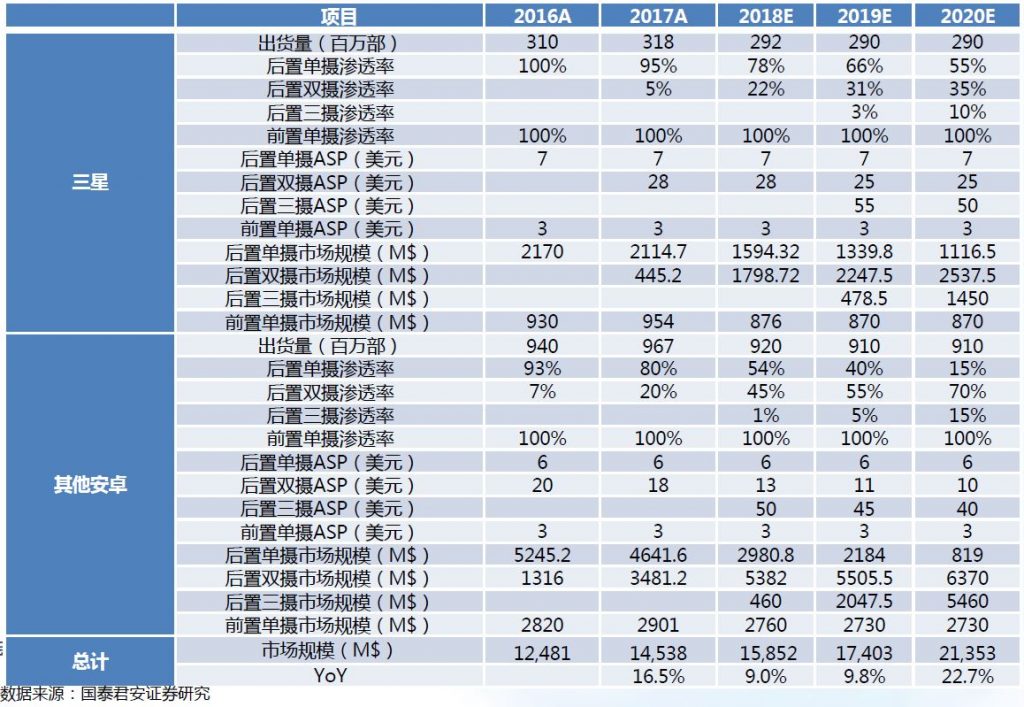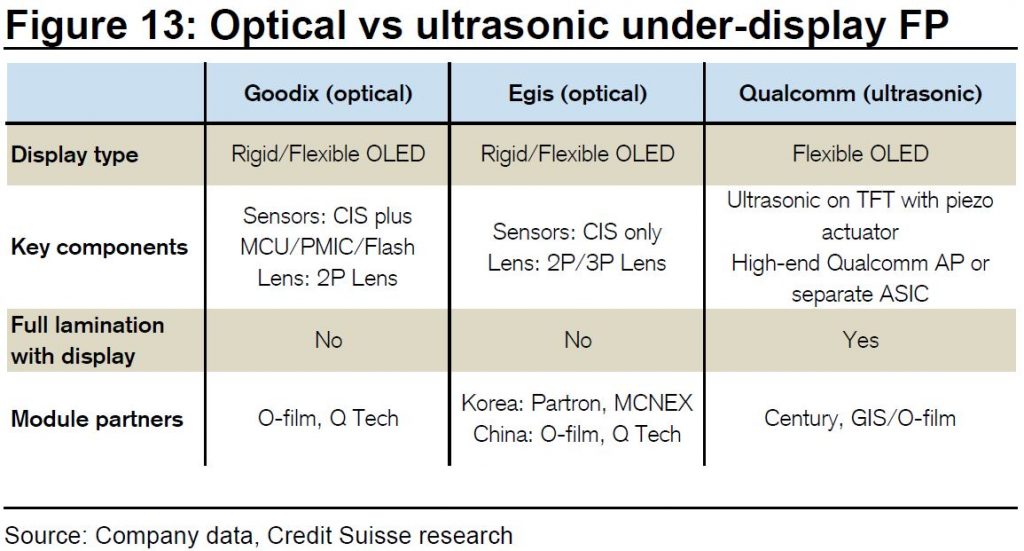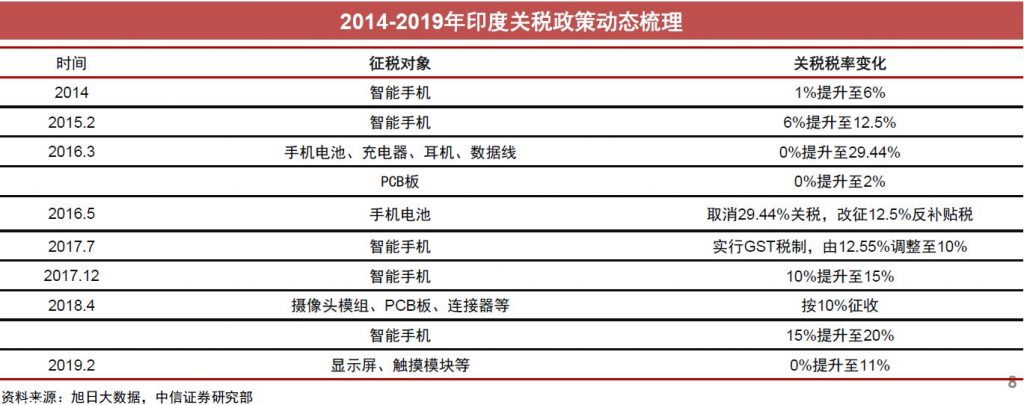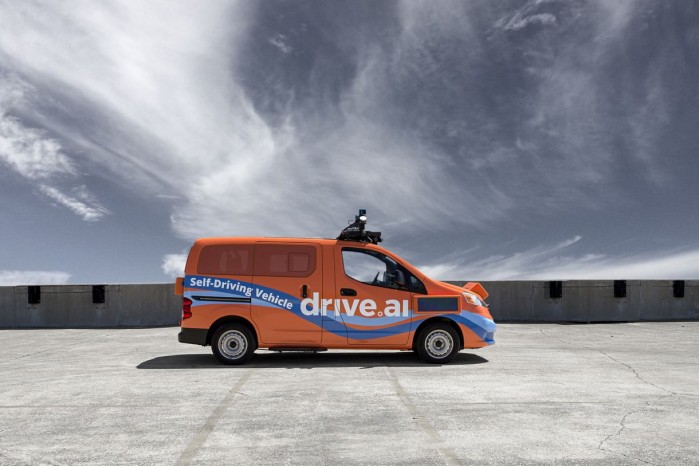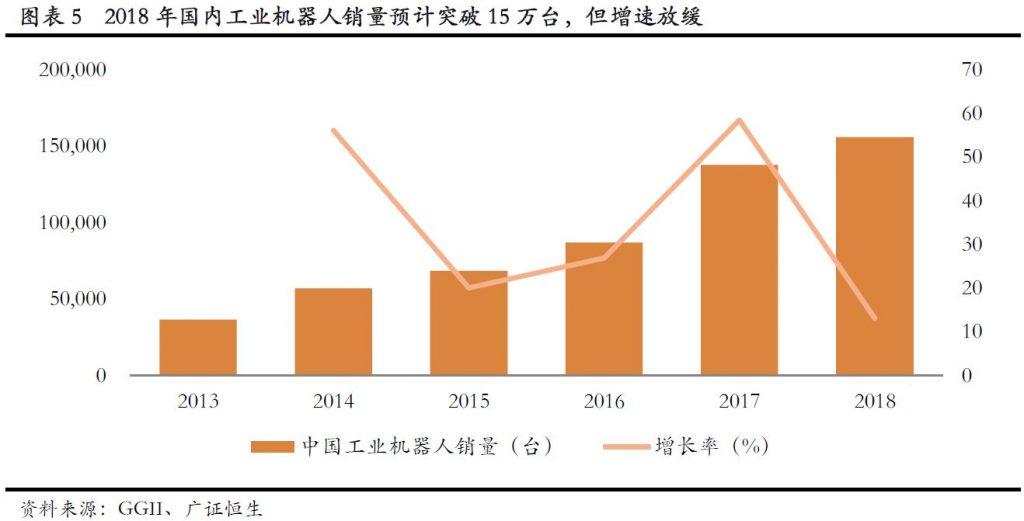
03-04: A series of data – Samsung has set the production of its first foldable phone at 1M units; The global foldable phone shipment is expected to reach 3.2M units in 2019; etc.
Chipsets
Huawei smartphone shipment aims at 250M units in 2019, wherein chip increment focuses on HiSilicon. IHS Markit predicts that HiSilicon shipments will maintain rapid growth, and 4G chip market share will exceed MediaTek. (IHS Markit report)
According to IHS Markit, the market demand is poor, and it is predicted that in 2019, the capacity utilization rate of major wafer factories will below as a whole. Currently, TSMC’s 7nm technique is mainly applied in mobile phone chips, including Apple A12, Kirin 980,and Qualcomm Snapdragon 855. (IHS Markit report)
According to chip and mobile phone manufacturer progress, in 2019, all of 5G smartphones will use separate baseband chips, with focus on Qualcomm Snapdragon X50 modem, and Huawei will use HiSilicon chips. The total cost increase of chips, RF front end and antenna FPC amounts to about USD80. (IHS Markit report)
From the growth history of the 3 global RF front-end giants (Avago, Skyworks, Qorvo), it can be seen that each round of wireless communication technology upgrade will bring about a large expansion of the RF front-end market. (Guotai Junan Securities report)
According to Guotai Junan Securities, the costs of the 5G RF front-end will be greatly increased. Taking high-end models as an example, the cost of 5G relative to 4G RF front-end will increase from USD12.6 to USD34.4, an increase of 173%. (Guotai Junan Securities report)
Touch Display
According to Digitimes, Samsung has set the production of its first foldable phone at 1M units. Samsung’s overall smartphone shipment could reach 300M units a year, so the share of foldable phones is not high. Currently, there are very few manufacturers that can produce foldable OLED panels. Samsung Display’s production capacity of folding displays is about 200K pieces per month (calculated by modules). Even with 100% production yield, only up to 2.4M units of foldable displays could be produced throughout the year. Industrial Securities has listed the supply chain for Samsung Galaxy Fold foldable phone. (Industrial Securities report)
According to Digitimes, the global foldable phone shipment is expected to reach 3.2M units in 2019 and 50.1M units in 2022. According to Digitimes’ foldable display shipment forecast, the situation of foldable display compared with the situation without foldable display, the flexible OLED consumption area of smartphones increased by 2%, 4%, and 6% in 2020, 2021 and 2022, respectively. (Industrial Securities report)
Korean vendors Samsung Display (SDC) and LG Display (LGD) mainly expand their production lines in the higher generation line, portion of which is for OLED TVs. BOE invests continuously and currently deploys 4 flexible OLED production lines in Chengdu, Mianyang, Chongqing and Fuqing, with a total production capacity of 192K units per month. China’s manufacturers including Tianma, CSOT, Visionox and EverDisplay are generally active, and have deployed Gen-6 of flexible OLED production lines. (Industrial Securities report)
Based on Digitimes’ supply chain research, GF Securities consolidates the main supply chain, production chain and other domestic or foreign mature vendors for foldable phone Samsung Galaxy Fold. (GF Securities report)
Gree Electric’s president Dong Mingzhu indicates that Gree’s mobile phone is going to follow the market development trends, with 5G phone and flexible display. Dong Mingzhu also believes that in the new era, entrepreneurs have to give up the practice of profit-seeking. (My Drivers, CN Beta, East Money)
Credit Suisse indicates Android smartphone brands are turning more aggressive in adopting under-display fingerprint-sensing, instead of 3D facial recognition, as they aim to increase the viewable area of the smartphone, not to mention 3D-sensing has much higher BOM cost than under-display fingerprint-sensing and the requirement of cutting a notch on the display panel. Credit Suisse estimates full-screen display penetration to reach 85% in 2019 and 90% in 2020, up from 12% in 2017 and 66% in 2018. (Credit Suisse report)
According to IHS Markit, diversified display forms will hope to be united to semi-circular notch and hole design. (IHS Markit report)
Camera
In 1H19, supply of 0.8µm CIS new products is concentrated on Sony and Samsung, and high-end models give priority to use Sony, while OminiVision is expected to realize mass production in 3Q19. It is predicted that Sony supply will be around 150M units in 2019, wherein, Huawei, Xiaomi and vivo are first guaranteed; Sony CIS overall supply has risks, especially for other phone vendors. (IHS Markit report)
In terms of cost, the selection of tri-cam specifications can have different combinations, with a relatively great cost elasticity. Wherein, all of Huawei and OPPO’s flagship models begin to use periscopic tri-cam solutions, which can support 5× optical zoom and 10× digital zoom. (IHS Markit report)
According to Guotai Junan Securities, 2016 data shows that the top 5 manufacturers of CCM manufacturers’ shipments and market share forecasts (M units) in 2016-18 are 33%, and in 2017 this figure is 37.3%, and in 2018 will continue to increase to 46.02%. (Guotai Junan Securities report)
In recent years, the Android camp has been more active in optical innovation: for instance, in the dual-cam adoption, the order from Huawei to Apple and to other Android phones emerges. For tri-cam, Huawei leads the pack. In 2018, the Android camp has also introduced a telescopic lens (vivo NEX) and a dual-track periscope structure (OPPO Find X). (Guotai Junan Securities report)
Memory
According to IHS Markit, while LPDDR5 will begin shipping in 2019, LPDDR4 will remain the dominant technology through 2022. 8GB DRAM smartphones are beginning to show up in the market, but will not gain meaningful market share until 2020 when they will approach 7% of all smartphones. (IHS Markit report)
Biometrics
Credit Suisse believes under-display fingerprint-sensing will become the mainstream biometric identification method for high-end Android smartphones by 2019-2020. The proliferation of front-facing 3D-sensing in Android will remain slow given higher bill-of-materials (BOM) costs (USD20 vs. ~USD5 for under-display fingerprint). Credit Suisse estimates under-display fingerprint shipment growing from 30M units in 2018 to 185M units in 2019, with 135M / 50M for optical-sensing/ultrasonic sensing. By 2020-2021, the industry could shift to new structures for half- or full-screen-sensing. (Credit Suisse report)
Credit Suisse believes Goodix and Egis are the only 2 capable solution providers in the market, though Silead, Elan, FocalTech, Novatek, etc., are working on their designs. Credit Suisse thinks algorithm is the key entry barrier for optical under-display fingerprint sensing since the key components like CMOS sensor, 2P/3P lens, MCU, holder, filter, etc., are not critical components for outsourcing. (Credit Suisse report)
Credit Suisse believes optical under-display will outgrow ultrasonic under-display given lower production cost (USD5-6 vs. USD15), multiple solution suppliers (Goodix / Egis / others vs. Qualcomm), and better flexibility for selecting the processor. Majority of the shipment of ultrasonic under-display fingerprint solution in 2019 will be for Samsung’s flagship models as Samsung has entered into a licensing agreement on the ASIC with Qualcomm, while the Chinese brands will be adopting optical sensing solution. (Credit Suisse report)
Phone
On 21 Jan 2019, the Indian government proposed to local manufacturers that “the time required to produce display screens and touch modules locally will be advanced from 2019-2020 to Feb 2019, otherwise an 11% import tariff will be imposed”. After adjustment, the imported mobile phone must bear 20% of the basic tariff and 35%-40% of the value-added tax, while the imported components of the local production of mobile phones must bear the tariffs of different component rates and 15%-20% of the value-added tax, as well as local production of 12% VAT on mobile phones. (Citic Securities report)
Automotive
Just 3 months after raising USD50M in Series A funding, e-scooter rentals startup Voi Technology has added another USD30M to its balance sheet. The new round sees existing investors Vostok New Ventures, Balderton Capital, LocalGlobe and Raine Ventures participate again, alongside new investors Project A and Creandum. (TechCrunch, CN Beta)
Self-driving vehicle tech developer Drive.ai has reportedly hired an investment banker to help it find potential buyers. The Mountain View company has hired investment bank Jefferies as an adviser and in recent weeks told bigger rivals it is interested in selling. (CN Beta, Biz Journals, The Information)
Robotics
According to the 2018 China Robot Industry Development report, the global robot market will reach USD29.82B in 2018, with a growth rate of 15.90%. The Chinese robot market will reach USD8.74B, with a growth rate of 25.94%. The scale of the robot market has maintained a growing trend, and the growth rate of the Chinese market has continued to be higher than the global level, but the growth rate has slowed down. At the same time, as the world’s largest robot market, China’s market share continues to rise, accounting for 26.97% in 2017 and 29.31% in 2018. (GuangZheng Hang Seng report)
The monthly output of the industrial robots in China has changed seasonally. In early 2019, its monthly production has reached 14,000 units, with about 35% growth on year. Yet because of supply chain costs pressure and the trade issue between China and US, the monthly production will reduce to 11,000 units averagely in 2H19. Overall, from 2015 to 2018, the output increased from 32,996 units to 147,682 units. In 2018, the output of China’s industrial robots exceeded 140,000 units, with a growth rate of 12.67%, which slowed down and the annual output continued to rise. (GuangZheng Hang Seng report)
